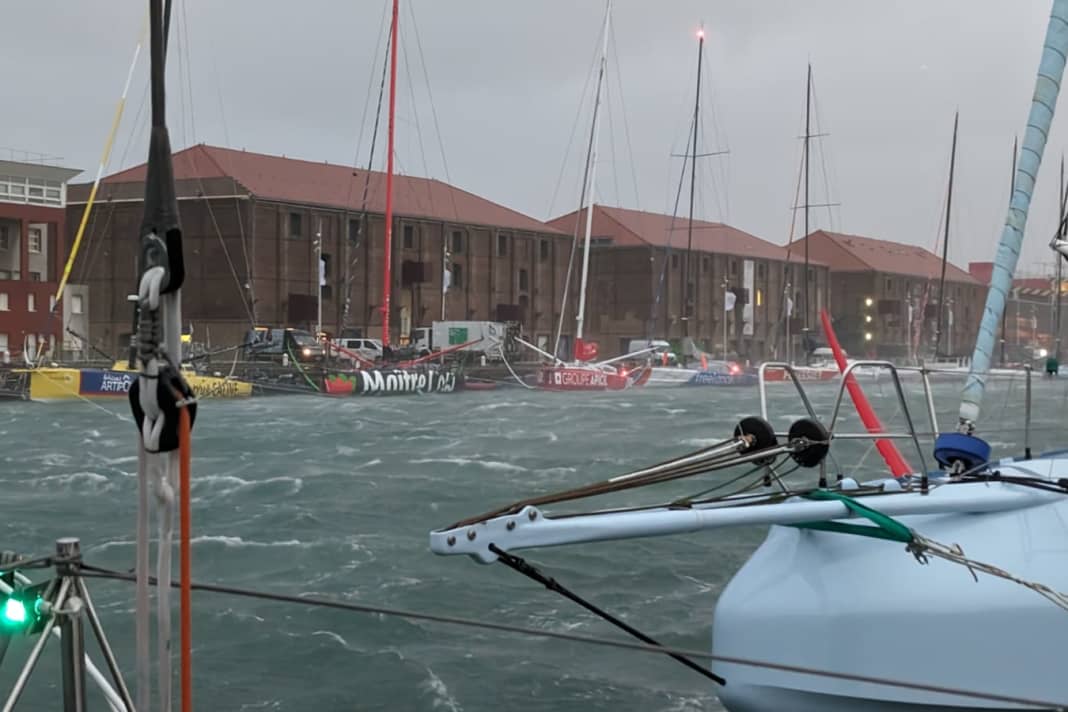Transat Jacques Vabre: Relief in the harbours, but the situation remains challenging






Hurricane Ciarán caused major damage on the French Atlantic coast, but the Transat fleets in Le Havre and Lorient escaped largely unscathed. The strongest winds were measured in the early morning of 2 November. A gust of almost 210 km/h was recorded on the coast of the Département du Finistère. The storm, combined with a sharp rise in sea level, led to high waves off the coast of Brittany. South of Molène, one of these waves reached a height of 21 metres.
The fleet was very well prepared" (Melwin Fink)
"Everything is fine for now," reported Team Malizia's skipper Boris Herrmann on Thursday morning. In Le Havre, the Imoca fleet had successfully sheltered from the storm with "Malizia - Seaexplorer". The teams in Lorient, where the Ocean Fifty and Class 40 transat boats awaited the storm in La Base harbour, were also able to breathe a sigh of relief.
"Sign for Com" co-skipper Melwin Fink said in Lorient: "Everything went well. Our boat is in one piece. The fleet was very well prepared. Someone spent the night on every boat, including ours. In addition, six people from the TJV team helped. They really did a great job." Fink said that he had never even imagined such wind forces before. In the well-protected harbour of La Base, it stormed overnight with up to 80 knots. "It was amazing to see how relatively calm the water remained despite this. Impressive!" said Fink.
Night watches for the Transat boats
Technician Mathieu Ravier from the Imoca team Foussier-Mon Courtier Energie took stock under the heading "A stormy night": "Some of you will have noticed: Last night in Le Havre, the lights of some Imocas were switched on. However, the ships were in the harbour. The lights signalled that there were people on board. When I say people, I mean some skippers and many technicians. These people you see working on the boats took turns keeping watch throughout the night."
Mathieu Ravier went on to write: "You would think: They don't sail at all! No, but they protect these racing machines of the seas, these technical beasts that seem so fragile in the face of the storm. In addition to the watchmen and watchwomen, the race organisers and their team were on standby in case of alarm situations. There's no need to thank them all, but it's important to remember that even in a storm, there are hands that are present day and night to ensure the welfare of our sea monsters. Honestly, there's nothing like that in Formula 1."
Timetable for Transat continuation uncertain
Mathieu Ravier wrote his lines at around 2 a.m. before carrying out the next Imoca safety check. Like him, the technical teams of all the racing teams, including many Malizians, have been up all night. While the sailors and organisers can now breathe a sigh of relief, thanks in part to them, planning the Transat start for the Imocas and the restarts for Ocean Fifties and Class 40s remains more than challenging.
"It's always 40, 50 knots out there," Melwin Fink is not the only one who knows. Although the Transat Jacques Vabre organisers have set their sights on next Sunday (5 November) for the restart of the Imocas and would like to send the Ocean Fifty and Class 40 fields into the race as soon as possible from Monday, the conditions remain extremely difficult and the probability of starting is - for the time being - not very high.
Atlantic lows are still to be expected
Many experts don't even see a chance of a start until the end of next week around 10 November. Sebastian Wache, meteorologist at Wetterwelt, explains: "If things go well, a window may open next Friday. The European model offers this glimmer of hope, but it is by no means certain. Other models don't even see the fundamental advance of the high." Further areas of Atlantic low pressure are also expected in the coming week.
The consequences of this are tough for the Transat Jacques Vabre Normandie Le Havre and everyone involved. The organisers in the French ports and also in the Caribbean destination port of Fort-de-France on Martinique have to reschedule time and again. The same goes for teams, partners and fans. Thousands of flight and accommodation bookings are affected. The waiting loop is becoming increasingly expensive for everyone.
Exciting Ultim race at sea
The Ultims do not have the worries of the other three classes and the organisers. Even four days after the start, only 14 nautical miles separate the first three multihull giants. Armel Le Cléac'h and Sébastien Josse took the lead again on Thursday afternoon. They were followed almost bow to bow by "SVR Lazartigue" with François Gabart and Tom Laperche and defending champion Charles Caudrelier with Erwan Israël on "Edmond de Rothschild". After a previously flat passage, the trio were travelling at breakneck speed again on Thursday with speeds of between 30 and 35 knots.
Video: Ultimate power in XL dimensions!
The summary from 1 November shows how the mighty multihulls were stuck in the doldrums and used the time for repairs before they are now back in roaring "flight mode":
At this point, you will find external content that complements the article. You can display and hide it with a click.

